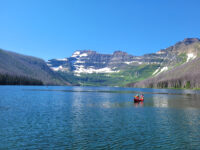Water restrictions for Milk River
By Jensen, Randy on August 18, 2020.
Tim Kalinowski
Lethbridge Herald
tkalinowski@lethbridgeherald.com
The Town of Milk River has brought in additional water restrictions and is making other contingency plans should the ongoing work on the St. Mary Diversion Drop 5 and Drop 2 structures in Montana carry on past September.
Currently there is almost no water moving through the Milk River, which relies on St. Mary Diversion water for nearly all of its flow.
“It is pretty sad-looking,” says Town of Milk River Mayor Peggy Losey when asked about how the river is looking at the moment. “There are lots of puddles. It looks like a dry riverbed with some puddles. There is not even a trickle flowing through it really. There are places where the water was deeper, and there are ponds there now. But it is not really running.”
The town’s reservoir is sitting at about 80 per cent capacity at the moment, Losey confirms, with local utilities largely unable to draw additional water from the river itself to replenish it.
“We are on Stage 2 water restrictions,” she explains. “That means we are asking people to conserve water as much as possible. We have also asked our car wash to reduce their hours of operation to help conserve water. And people can hand water their flowers or garden, but absolutely no lawn watering.”
Losey praises residents of the community who have managed to cut their consumption in half in recent months. The townspeople are well aware of what it is stake, says Losey, and have, sadly, become used to this type of water rationing in recent times due to multiple years of drought even before the drop-structure failure back in May which set off the current crisis.
“This is the third year in a row we have had to put our residents on water restrictions, and so we are definitely looking at some more permanent type of water security,” she says.
According to Losey, the timing of the repairs taking place south of the border is critical.
“It isn’t the amount of water where our problem is -it is the date,” she states. “If they can’t have water flowing in the river by the end of September, because our river is basically an irrigation canal with siphons, they can’t be running water through that in the winter time or it will freeze up and wreck a lot more of the infrastructure. So we are thinking if freeze-up comes at the end of October or the middle of October, we have to have some emergency measures in place by the beginning or middle of September.”
Losey says the Town is in deep discussions with its provincial and federal representatives to come up with a contingency supply plan if the repairs fail to meet that September timeline.
“We have been considering a temporary overland pipe, but this is all the Alberta government and Alberta Environment,” she explains. “Minister Grant Hunter, our MLA, has been working very closely with us, and he is trying to get us the help we need. And (MP) Glen Motz has also been helping us out a lot.”
The temporary pipeline would run from Middle Coulee north of the community of Warner, says Losey.
“Sure, we can truck water in, but that is going to cost huge amounts of money,” she says. “The pipeline is far less expensive because for farmers moving water right now they do have pipe available, and pumps. They have all the stuff we can use if we needed it.”
Losey says ideally these contingency plans won’t be activated, but feels if this crisis has taught local stakeholders and the province anything, it is time to urgently address the region’s long-term water security issues in a more substantive way.
“We are talking to Minister Hunter and MP Motz, and we are trying to come up with more water security for our communities,” she says. “Because it is not just Milk River, it’s also Coutts, and Coutts supplies water for Sweetgrass, Montana. And then we have two rural pipelines that run off our water system. So it’s not just Milk River; there are a lot more people involved.”
Follow @TimKalHerald on Twitter
20-19




